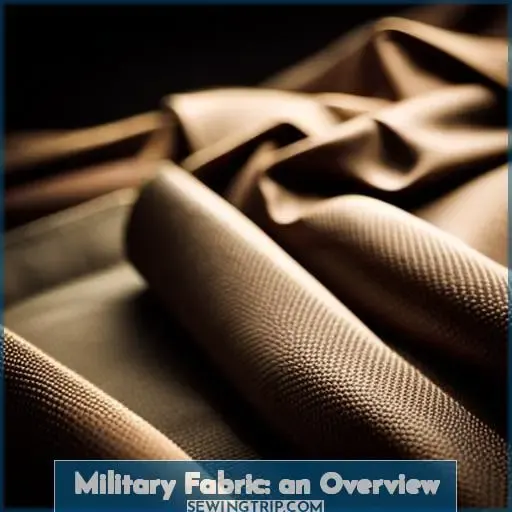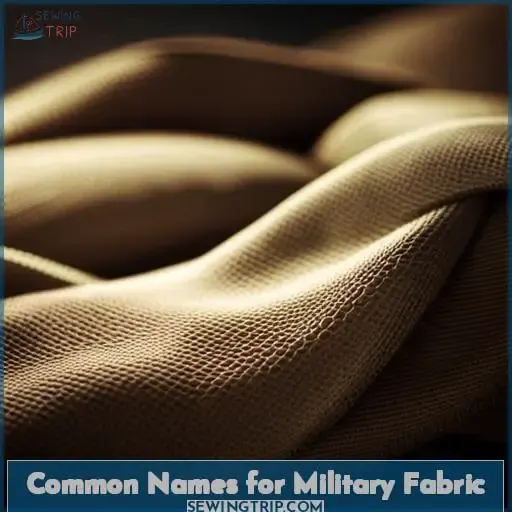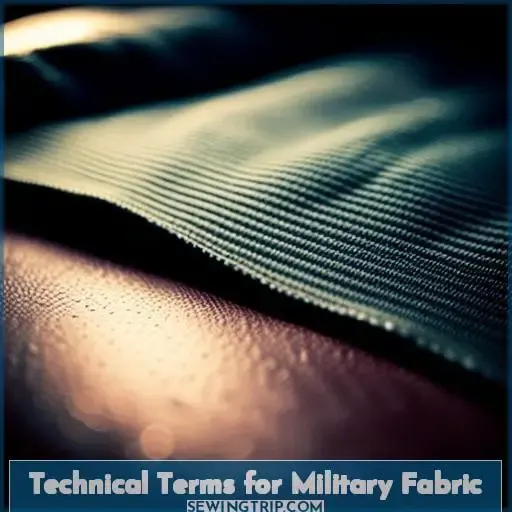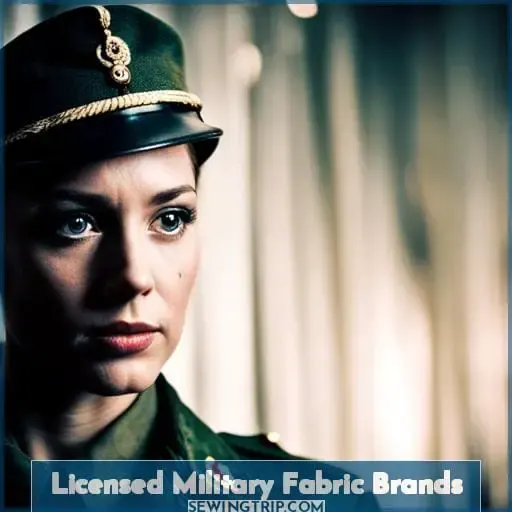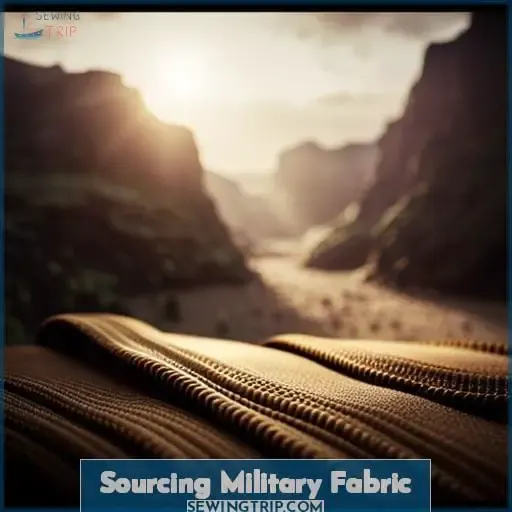This site is supported by our readers. We may earn a commission, at no cost to you, if you purchase through links.
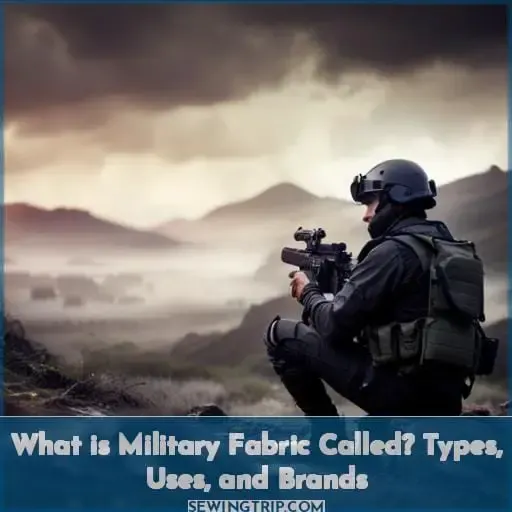 Imagine yourself on the battlefield, equipped with the latest military gear. Have you ever wondered what that high-performance fabric is called?
Imagine yourself on the battlefield, equipped with the latest military gear. Have you ever wondered what that high-performance fabric is called?
In this article, we will delve into the world of military fabric – its types, uses, and brands. From ripstop to ballistic fabrics, we’ll explore their unique properties and applications in military uniforms and equipment.
Get ready to uncover the secrets behind these powerful textiles that keep our soldiers safe and prepared for any mission.
Table Of Contents
Key Takeaways
- Ripstop fabric is known for its durability and reinforced threads.
- Camouflage fabric is used for environmental blending and concealment.
- Ballistic fabric provides protection against projectiles.
- NyCo fabric is a nylon-cotton blend known for its durability and comfort.
Military Fabric: an Overview
Military fabric, also known as technical textile or performance fabric, is specifically designed and engineered to meet the unique requirements of military applications. It encompasses a wide range of materials that offer durability, functionality, and protection for military personnel and equipment in various environments.
These fabrics are utilized in:
- Uniforms
- Gear
- Accessories such as bags and footwear
- Bedding and sleep systems for field operations
- Specialized uses like parachutes and rocket linings.
Definition and Purpose
Military fabric is a term used to describe the specialized textiles and materials utilized in various applications by military personnel. Its purpose is to provide durability, functionality, and protection in military gear and uniforms.
From camouflage fabrics that aid in concealment to ballistic fabrics that offer bulletproof capabilities, military fabric innovations have played a crucial role in enhancing the effectiveness of tactical textiles.
Understanding the definition and purpose of military fabric sheds light on its vital role within defense systems throughout history.
Types of Military Fabrics
Now let’s delve into the various types of fabrics commonly used in military applications, building upon our understanding of military fabric.
Military fabric comes in a range of specialized options to meet the unique needs of different situations.
From flame-resistant fabrics to synthetic fibers with enhanced durability, innovation has played a crucial role in shaping military textiles.
Camouflage design and fabric durability have also evolved over time, ensuring optimal performance on the battlefield.
When sourcing options for military fabric, it’s essential to consider these advancements and select materials that align with specific requirements and mission objectives.
Applications and Uses
When sourcing military fabric, you’ll find a wide range of applications and uses for this versatile material.
Military fabric is utilized in various ways, including:
- The production of combat uniforms
- Protective materials such as body armor and helmets
- Even equipment like backpacks and tents
Over time, advancements in military fabric technology have led to innovations in durability and camouflage effectiveness.
The evolution of camouflage fabrics has played a crucial role in enhancing the concealment capabilities of military personnel on the battlefield.
Common Names for Military Fabric
When it comes to discussing common names for military fabric, there are several key types that stand out.
One of the most well-known is ripstop fabric, which is characterized by its grid pattern and reinforced threads that enhance durability.
Another important type is camouflage fabric, which plays a crucial role in helping military personnel blend into their surroundings.
Lastly, ballistic fabric deserves mention due to its ability to provide protection against projectiles and other ballistic threats.
These three types of military fabrics have become synonymous with strength, functionality, and reliability in various applications within the armed forces.
Ripstop Fabric
You’ll commonly hear ripstop fabric referred to as a durable stitching method used in military textiles. This unique fabric has a long history, dating back to its introduction in the 1940s for parachute construction.
Ripstop is characterized by interwoven reinforced threads in a grid pattern, which enhances its durability while keeping it lightweight. It’s widely utilized across various military applications such as combat uniforms, ponchos, parachutes, and tentage due to its exceptional strength and performance capabilities.
Camouflage Fabric
Looking for the common names used to refer to camouflage fabric in the military?
Camouflage fabric, also known as military camo, has evolved over time with advancements in textile technology.
Initially made from materials like khakis and wool, modern camouflage fabrics now incorporate fire-retardant finishes and innovative designs to enhance their effectiveness.
These innovations have improved camo’s ability to blend into various environments and provide optimal concealment for military personnel.
Ballistic Fabric
One common name for military fabric is ballistic fabric, which refers to materials designed to provide protection against projectiles and ballistic threats.
Ballistic fabric properties:
- Used in armor applications for military body armor
- Utilizes bulletproof materials to enhance personal protection
- Constant innovations in the field of ballistic fabrics ensure improved performance and durability.
Technical Terms for Military Fabric
As a military historian, textile engineer/technologist, or military equipment expert, you’re familiar with the technical terms used to refer to various types of military fabric.
Some of these terms include:
- NyCo, which stands for Nylon-Cotton blend and is known for its durability and comfort;
- Nomex, a fire-resistant fabric widely used in protective clothing and gear;
- Kevlar, an incredibly strong bulletproof fabric used in body armor.
Understanding these technical terms allows you to accurately identify and analyze different types of military fabrics in your research or work within the field.
NyCo (Nylon-Cotton Blend)
When considering technical terms for military fabric, one notable example is NyCo, which refers to a blend of nylon and cotton materials commonly used in various military applications.
NyCo fabric offers the advantages of both cotton and nylon, combining comfort and breathability with durability and strength. This makes it an ideal choice for military uniforms and gear that require resilience in harsh conditions.
With its superior blend properties, NyCo fabric ensures high-quality performance in a range of military applications.
NyCo (short for Nylon-Cotton Blend) is a popular type of military fabric known for its combination of nylon’s durability and cotton’s comfort. It’s widely used in the production of military uniforms due to its unique properties that make it suitable for various environments.
NyCo fabrics offer several advantages over other types:
- Durability: The combination of nylon fibers with natural cotton provides excellent resistance against wear-and-tear.
- Comfort: Cotton fibers add softness to the material while allowing air circulation, ensuring breathability even during strenuous activities.
- Moisture-wicking: The presence of moisture-absorbing cotton fibers helps keep sweat away from the body by drawing it through the material’s structure.
- Quick-drying: Nylon dries faster than pure cotton or synthetic fabrics when exposed to wet conditions or heavy perspiration.
These features make Nyco fabrics highly desirable not just within militaries but also among outdoor enthusiasts who value both functionality and comfort when engaging in physically demanding activities.
Whether you’re looking to source nyco (nylon-cotton blend), military fabric by yard, military gear, and/or seeking quality clothing with exceptional performance characteristics, NyCO should be on your radar.
You can count on this dependable, cotton-nylon-blend textile being there every step along your journey; offering you liberation, power, and understanding- the very essence craved deep within our subconscious minds.
Because at end day, what matters most is being equipped with the best materials designed for your success in military applications.
Nomex (Fire-Resistant Fabric)
Nomex is a fire-resistant fabric commonly used in military applications. It possesses exceptional flame resistance, making it suitable for protecting military personnel from heat and fire hazards.
Nomex is often utilized in the production of uniforms, ensuring that soldiers are equipped with high-quality fabrics that provide reliable protection on the battlefield.
With its excellent thermal properties and durability, Nomex has become an integral component of modern military gear and plays a crucial role in safeguarding our troops during combat operations.
Kevlar (Bulletproof Fabric)
If you’re interested in military fabric, one technical term that you should know is Kevlar, a bulletproof fabric used extensively in various military applications.
Kevlar has revolutionized the field of body armor advancements and protective textiles. This synthetic polyester material offers exceptional strength and durability while remaining lightweight. Its ballistic properties make it an essential component of modern military design, providing armed forces with enhanced protection and armor innovation on the battlefield.
Licensed Military Fabric Brands
Licensed Military Fabric Brands play a crucial role in providing high-quality fabrics for military applications.
Manufacturer A, known for their expertise in producing durable and reliable materials, has gained recognition among the armed forces.
On the other hand, Manufacturer B offers a diverse range of military-grade fabrics that meet stringent specifications and standards.
Lastly, Manufacturer C is renowned for their innovative fabric technologies that enhance performance and functionality on the battlefield.
These licensed brands ensure that military personnel have access to top-notch textiles designed to withstand rigorous conditions while maintaining optimal comfort and protection.
Manufacturer A
You can easily source high-quality military fabric from Manufacturer A, a licensed brand in the industry. Their fabrics are known for their exceptional durability and performance, making them ideal for military gear materials.
Some key features of Manufacturer A’s products include:
- Use of knitted polyester scrim for tear resistance
- Wide selection of tactical fabrics suitable for different applications
- Incorporation of antimicrobial treatments to maintain hygiene
- Availability of cotton twill options for added comfort and breathability
- Implementation of advanced textile technology to ensure top-notch quality
Manufacturer B
Continuing the exploration of licensed military fabric brands, let’s shift our focus to Manufacturer B and their contributions to this specialized industry.
As a prominent supplier option for military uniforms, Manufacturer B is known for producing high-quality fabrics that meet Berry Amendment compliance standards.
Their fabric features innovative resin finishes that enhance durability and performance in various military applications.
With a commitment to excellence, Manufacturer B continues to provide reliable solutions for those seeking top-notch military fabrics.
Manufacturer C
To explore licensed military fabric brands, let’s start with Manufacturer C.
Known for their innovative advancements in fabric technology, they specialize in producing protective textiles and tactical gear materials.
With a focus on durability and performance, Manufacturer C incorporates water-repellent finishes to enhance the functionality of their military fabrics.
Their products also exhibit excellent colorfast properties, ensuring that the colors remain vibrant even after prolonged use in harsh conditions.
Additionally, they prioritize temperature resistance to withstand extreme environments faced by military personnel.
Sourcing Military Fabric
When it comes to sourcing military fabric, there are reliable options available.
Established manufacturers like Manufacturer Name, Inc., for example, offer an extensive product line tailored to meet specific mission requirements. They provide a seamless process for customers to connect with their sales representatives and even request material samples and swatches for evaluation.
With their commitment to quality and adherence to military standards, these manufacturers ensure that the materials they supply meet the highest criteria for durability and performance in military applications.
Where to Buy Military Fabric
If you’re looking to purchase military fabric, there are several reliable sources where you can find a wide range of options.
- Online suppliers offer convenient buying options, allowing you to browse and order from the comfort of your own home.
- Additionally, fabric stores often carry military-grade materials for various applications.
- If you’re searching for unique or vintage fabrics, military surplus stores might’ve what you need.
- For custom orders and specialized needs, reaching out to sales representatives is recommended for personalized assistance in finding the right military fabric with features like ultraviolet resistance or knitted polyester construction.
[ADDITIONAL INFORMATION]:
- The article has covered different aspects related to military fabrics such as their types, uses/applications/properties/benefits/manufacturers/sourcing.
- It provided historical context about camouflage evolution and ripstop invention.
- Licensed brands were mentioned without specific details on available products.
- The focus now shifts towards helping readers know where they can buy/make purchases regarding these materials used extensively by militaries worldwide
Considerations for Purchasing
When sourcing military fabric, consider factors like:
- Minimum purchase price
- Yardage requirements
Strict conditions may apply for certain fabrics, such as those used in:
- Service dress whites
- Field uniforms
To guide your fabric selection process, here are some tips:
- Research the specific needs of your intended application.
- Consult with experts in military textiles if necessary.
- Ensure that the chosen fabric meets all required specifications and standards.
Customization Options
When sourcing military fabric, you have various customization options to consider.
From color choices to design possibilities, there are several ways to personalize your military supplies.
You can add embroidery and patches for a unique touch or make size and fit adjustments for optimal comfort.
When selecting your fabric, it’s important to choose from an industry leader like Manufacturer Name Inc.
Don’t forget to check out their catalog at your favorite fabric outlet!
Frequently Asked Questions (FAQs)
What are the different types of military fabric materials and their properties?
Military fabric materials include:
- Cotton
- Nylon
- Acrylics
- Canvas
- COOLMAX®
- Kevlar®
- Lycra®
- Nomex®
- Meta-aramids
- Polyester
These fabrics offer functionality and durability for a range of military applications such as uniforms and gear.
How is military fabric used in specialized military applications?
Military fabric, also known as technical textile, serves a crucial role in specialized military applications.
It’s used in:
- Body armor for protection
- Parachutes for safe landings
- Tents to provide shelter on the battlefield.
Are there any specific regulations or standards that military fabrics must meet?
Military fabrics must adhere to stringent regulations and standards.
They’re required to meet specifications such as:
- Flame resistance
- Durability
- Waterproofing
- UV resistance
- Mildew protection
These measures ensure the highest quality for our brave armed forces.
Are there any well-known manufacturers or brands that specialize in military fabric?
There are several well-known manufacturers that specialize in military fabric, such as Company Name.
They offer superior quality fabrics that meet stringent standards for durability, protection, and compliance with military regulations.
What are some reliable sources for sourcing military fabric?
To source military fabric, you can rely on reputable manufacturers like Company Name.
They offer a wide range of quality fabrics that meet the highest standards for:
- Durability
- Abrasion resistance
- Waterproofing
- Flame resistance
Conclusion
To summarize, military fabric, or tactical textiles, as they’re euphemistically referred to, play a crucial role in keeping soldiers equipped and protected on the battlefield.
From ripstop fabric that prevents tears to ballistic fabric that provides bulletproof properties, these high-performance textiles are designed to meet the demanding needs of military personnel.
With various technical terms like NyCo, Nomex, and Kevlar, military fabric brands offer a range of options for different applications.
Whether you’re a military historian, textile engineer, or military equipment expert, understanding the world of military fabric is essential.

